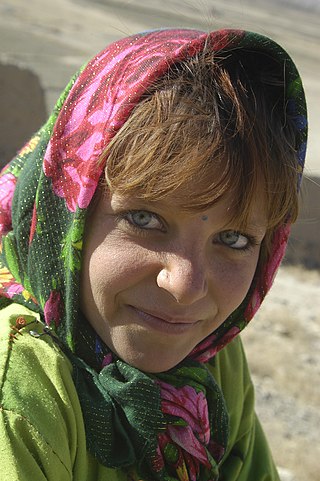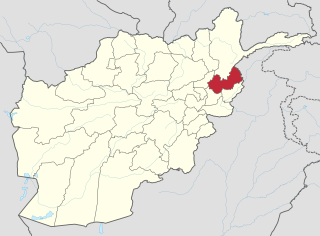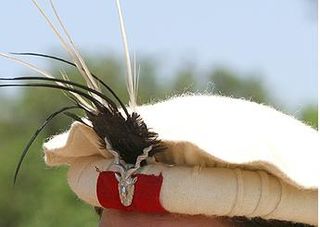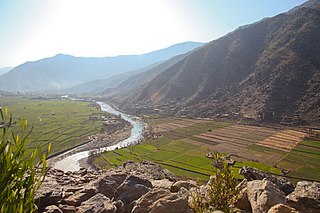Katawar or Katir is the name for the northern mountainous regions of Kafirstan in Afghanistan and Pakistan. The Black-Robed (Siah-Posh) tribes living in these regions are also known as Katawars or Katirs.
Katawar or Katir is the name for the northern mountainous regions of Kafirstan in Afghanistan and Pakistan. The Black-Robed (Siah-Posh) tribes living in these regions are also known as Katawars or Katirs.
Other names for the tribes are Kata, Kator and Katawer.
The Kafirs of Siah-Posh groups are descended from the ancient Kambojas.
Posh is an informal adjective for "upper class". It may also refer to:

Kāfiristān, or Kāfirstān, is a historical region that covered present-day Nuristan Province in Afghanistan and its surroundings. This historic region lies on, and mainly comprises, the basins of the rivers Alingar, Pech (Kamah), Landai Sin river and Kunar, and the intervening mountain ranges. It is bounded by the main range of the Hindu Kush on the north, Pakistan's Chitral District to the east, the Kunar Valley in the south and the Alishang River in the west.

The Nuristanis, formerly known as Kafiristanis, are an ethnic group native to the Nuristan Province of northeastern Afghanistan and Chitral District of northwestern Pakistan. Their languages comprise the Nuristani branch of Indo-Iranian languages.

Nuristan, also spelled as Nurestan or Nooristan, is one of the 34 provinces of Afghanistan, located in the eastern part of the country. It is divided into seven districts and is Afghanistan's least populous province, with a population of around 167,000. Parun serves as the provincial capital. Nuristan is bordered on the south by Laghman and Kunar provinces, on the north by Badakhshan province, on the west by Panjshir province.

The Nuristani languages, also known as Kafiri languages, are one of the three groups within the Indo-Iranian language family, alongside the much larger Indo-Aryan and Iranian groups. They have approximately 130,000 speakers primarily in eastern Afghanistan and a few adjacent valleys in Khyber Pakhtunkhwa's Chitral District, Pakistan. The region inhabited by the Nuristanis is located in the southern Hindu Kush mountains, and is drained by the Alingar River in the west, the Pech River in the center, and the Landai Sin and Kunar rivers in the east. More broadly, the Nuristan region is located at the northern intersection of the Indian subcontinent and the Iranian plateau. The languages were previously often grouped with Indo-Aryan or Iranian until they were finally classified as forming a third branch in Indo-Iranian.
The Kom or Kam are a Nuristani tribe in Afghanistan and Pakistan.
The Katir are a Nuristani tribe in Afghanistan and Pakistan.
Gish or Great Gish was the most popular god of Nuristani mythology and received the greatest amount of attention among the Siah-Posh Nuristani of Bashgul. Every village of Bashgul had one or more shrines dedicated to him. In the Nuristani pantheon, Gish ranked next to Moni who was said to be the chief prophet of Imra. Both Moni and Gish were created by Imra by his breath.
Moni or Mone, also known as Mandi was, after Imra, the second-most important god in the pre-Islamic pantheon of the Nuristani people. With his breath, Imra created Moni and Gish. Moni was believed to be a divine prophet, whom Imra selected to fulfill his behests. Nearly every village had a temple devoted to Moni.

The pakol or pakul is a soft, flat, rolled-up, round-topped men's cap, usually worn in Afghanistan and Pakistan. It is typically made of wool and found in a variety of earthy colours, such as brown, black, grey, ivory, or dyed red using walnut. The pakol is believed to have originated in Chitral, or Gilgit-Baltistan in Pakistan.

Kamkata-vari is the largest Nuristani language. It contains the main dialects Kata-vari, Kamviri and Mumviri. Kata-vari and Kamviri are sometimes erroneously reckoned as two separate languages, but according to linguist Richard Strand they form one language.

Afghanistan is a linguistically diverse nation, with upwards of 40 distinct languages. However, Dari and Pashto are two of the most prominent languages in the country, and have shared official status under various governments of Afghanistan. Dari, as a shared language between multiple ethnic groups in the country, has served as a historical lingua franca between different linguistic groups in the region and is the most widely understood language in the country. Pashto is also widely spoken in the region; but the language does not have a diverse multi-ethnic population like Dari, and the language is not as commonly spoken by non-Pashtuns. Dari and Pashto are also "relatives", as both are Iranian languages.

Afghanistan is a multiethnic and mostly tribal society. The population of the country consists of numerous ethnolinguistic groups: mainly the Pashtun, Tajik, Hazara and Uzbek, and minorities of Aimaq, Turkmen, Baloch, Pashai, Nuristani, Kurds, Gujjar, Arab, Brahui, Qizilbash, Pamiri, Kyrgyz, Sadat and others. Altogether they make up the Afghan people.

Watapur District is situated in the central part of Kunar Province in Afghanistan. It was split from Asadabad district. The district is mountainous with 60 large and small villages. The population is around 60,000. Degan, Safi, Ragakhel, Sharbekhel, Nanekhel, Doshakhel, Kohestani, Saidan are the few tribes living in this beautiful place. Watapur District has a high school located in south part of the district. The villages are located in the valleys or in the high mountains, with difficult or no road access to the center - Asadabad, and it takes one day to reach some of them. There was a medical clinic north of Qatar Kala, built by ISAF, until it was destroyed by local militants.
The Kingdom of Kapisa was a state located in what is now Afghanistan during the late 1st millennium CE. Its capital was the city of Kapisa. The kingdom stretched from the Hindu Kush in the north to Bamiyan and Kandahar in the south and west, out as far as the modern Jalalabad District in the east.
Mohammed Issa Nuristani was an army general and a community leader among the Safed Posh tribe in Nuristan, Afghanistan, who led a group of Nuristani people in rebellion against the Soviets at the start of the Soviet–Afghan War. He was assassinated early in the conflict.
Arabs in India are people with Arab origins who have over a long period of time, settled in the Indian subcontinent. There have been extensive trade and cultural links between India and the Arab world spanning several millennia. The west coast region of India, especially Malabar and Konkan coasts were active trading hubs, where Arab merchants frequently used to visit on their way to Sri Lanka and South East Asia. Over a span of several centuries, migrants from different Arabian nations immigrated to various regions and kingdoms of the Indian subcontinent as merchants, missionaries and through intermarriages.
Kasi is a Pashtun tribe from the Sarbani tribal confederacy, primarily found in Quetta, Pakistan and Nangarhar, Afghanistan. as well as in Iran, Palestine, Iraq.
Siah Push or Siyah Push or Seyah Push or Siyapush or Siahpush may refer to:
Katawar is a village in the Hadoti region of Rajasthan, India. It serves as a Gram panchayat for six nearby villages which are Manyagan, Achrawa, Bhojukheri, Mehla, Baldevpura. Bichhalas. The nearest town is Atru, which is 22 km away. It is located 52 km from the district headquarter, Baran.